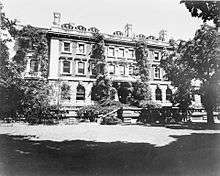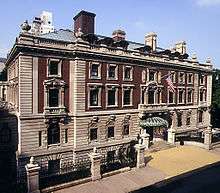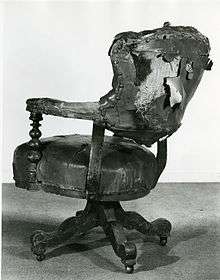Cooper Hewitt, Smithsonian Design Museum
Cooper Hewitt, Smithsonian Design Museum is a design museum located in the Upper East Side's Museum Mile in Manhattan, New York City. It is one of 19 museums that fall under the wing of the Smithsonian Institution and is one of three Smithsonian facilities located in New York City, the other two being the George Gustav Heye Center in Bowling Green and the Archives of American Art New York Research Center in the Flatiron District. It is the only museum in the United States devoted to historical and contemporary design. Its collections and exhibitions explore approximately 240 years of design aesthetic and creativity.[2]
.jpg) Garden and entrance to Cooper Hewitt | |
 Location of the museum  Cooper Hewitt, Smithsonian Design Museum (New York)  Cooper Hewitt, Smithsonian Design Museum (the United States) | |
| Established | 1896 |
|---|---|
| Location | Manhattan, New York, United States |
| Coordinates | 40.7844°N 73.9582°W |
| Director | Caroline Baumann[1] |
| Public transit access | New York City Bus: M1, M2, M3, M4, M86, M96, M106 New York City Subway: |
| Website | www.cooperhewitt.org |
History
The Cooper Hewitt Museum was founded in 1896. It was originally named Cooper Union Museum for the Arts of Decoration and it fell under the wing of the Cooper Union for the Advancement of Science and Art. In 1895, the granddaughters of Peter Cooper, Sarah Cooper Hewitt, Eleanor Garnier Hewitt and Amy Hewitt Green, asked the Cooper Union for a space to create a Museum for the Arts of Decoration. The museum would take its inspiration from the Musée des Arts Décoratifs, Paris. The museum would serve as a place for Cooper Union students and professional designers to study decorative arts collections. Cooper Union trustees provided the fourth floor of the Foundation Building. It opened in 1897.[2] It was free and open three days a week.[2][3]
The three sisters served as directors until Sarah Cooper Hewitt died in 1930. After her death, four directors were appointed to run the museum. Constance P. Hare served as chair. In 1938, Edwin S. Burdell became the director of the Cooper Union. The museum became his responsibility. The board of directors was abolished and an advisory council was established.[2]
Eventually the museum and art school started to distance themselves from one another in regards to programming. Other departments of the Cooper Union were making financial demands, and the Cooper Union announced that they would close the museum.[2] This led to the museum being closed on July 3, 1963.[4] Public outcry was strong against the closing. A Committee to Save the Cooper Union Museum was formed by Henry Francis Du Pont. The American Association of Museums (now the American Alliance of Museums) developed a case study about the future of the museum. Negotiations then began between the Cooper Union and the Smithsonian Institution. On October 9, 1967, Smithsonian Secretary S. Dillon Ripley and Daniel Maggin, the chair of the board of trustees, signed an agreement turning over the collection and library of the museum to the Smithsonian. On May 14, 1968, the New York Supreme Court approved the agreement and the museum fell under ownership of the Smithsonian. July 1, 1968, it was officially transferred to the Smithsonian, and the museum was renamed the Cooper-Hewitt Museum of Design. The following year, 1969, it was renamed as the Cooper-Hewitt Museum of Decorative Arts and Design.[2] In October of that year, Lisa Taylor became the director.[5]
The museum, which was the first Smithsonian museum outside of Washington, D.C., moved to its home at the Andrew Carnegie Mansion in 1970.[2] The Mansion was renovated and the museum opened to the public on October 7, 1976 with the exhibition "MAN transFORMs".[6] A conservation laboratory was opened in July, 1978. The Samuel H. Kress Foundation funded the lab and it focuses on textile and paper conservation.[7] Lisa Taylor retired in 1987 and in 1988 Dianne H. Pilgrim took her place as Director.[8] In 1994, the museum's name was changed again to Cooper–Hewitt, National Design Museum.[2] Pilgrim retired from the museum in 2000.[9][10] In 2000, Paul W. Thompson became Director.[10] From 2010 to 2012, Bill Moggridge, a co-founder of IDEO and designer of the first laptop computer, served as Cooper-Hewitt's director.[11] On June 17, 2014, the museum's name was changed again to Cooper Hewitt, Smithsonian Design Museum. A new graphic identity, wordmark, and new website were launched on this day. The identity was designed by Eddie Opara of Pentagram.[12] The website was developed by Matcha Labs.[12]
The museum began preparing for renovations in 2008. The mansion was closed to the public in July 2011, to begin the renovation period during which it held exhibitions at the headquarters of the United Nations[13] and on Governor's Island.[14] The museum opened a new online retail shop in 2012.[15] In 2012, the Cooper-Hewitt created an additional space in Harlem as an education facility. Designer Todd Oldham donated design services for the space.[16] Thirteen design firms were hired to work on the project, with total costs for the renovations totaling $91 million.[17]
In June 2014, the museum changed its name from Cooper-Hewitt, National Design Museum to Cooper Hewitt, Smithsonian Design Museum.[18] On December 12, 2014, the Cooper Hewitt reopened to the public. Renovations included an "Immersion Room", an interactive space that provides visitors digital access to the museums collection of wallpaper. The main exhibition space was expanded and the museum had a custom open-source font, which remains available for free download and modification, designed for its reopening. In 2015, the terrace and garden renovations were completed and opened to the public, with design led by Walter Hood.[19]
Museum building


The Cooper Hewitt is located in the Andrew Carnegie Mansion. The Georgian style mansion was built over the course of the years 1899 to 1902 and has 64 rooms. The home served as not only the home for Andrew Carnegie, his wife, and daughter, but also as his office for his philanthropic work after his retirement. The mansion was designed by Babb, Cook & Willard. It was the first private residence in the United States to have a structural steel frame. It was the first home in New York to have an Otis elevator. The elevator is now in the collection of the National Museum of American History. The home also had central heating and an early form of air-conditioning.[2] The property also has a large private garden.[20] In 1974 it was added to the National Register of Historic Places.[2] The conservatory, which is made of Tiffany glass, was renovated in 1975.[21] In 1995, the museum closed for a year for a $20 million renovation to connect the three buildings on the property, improve accessibility, and build a design study center. Funds for the 1995 renovation project included $13 million from the Smithsonian Institution and a $2 million donation by Agnes Bourne, an interior designer.[22]
In 2008, the museum started to undergo renovations.[2] The renovation costs $91 million[17] and is the largest in the museum's history. The renovation was partially financed by the museum endowment.[23] The museum reopened on December 12, 2014. Additional renovations were completed in 2015, including the property gardens.[17] To celebrate the reopening of the museum, the Cooper Hewitt released a downloadable 3D scan of the building, allowing users to explore the mansion from their computer, reuse and remix it, and print a 3D printer version of the building. It was released under a Creative Commons Zero license.[24]
Collections

The Cooper Hewitt collections consist of decorative and design objects. The museum's original collection focused on architecture, sculpture, painted architecture, decorative arts, woodwork, metalwork, pottery, costume, musical instruments and furniture.[3] Upon its opening, Abram S. Hewitt's wife, Sarah Amelia Hewitt donated a lace collection, George Hearn donated two fountains worth $1,000, and Lloyd Bryce's wife donated art and objects from the Palace of Fontainebleau.[3]
The museum had a metalwork gallery, which showcased historic iron grillwork and a room devoted to ironwork, both which no longer are focus rooms.[25][26] The museum has a wide variety of objects in its collection, ranging from matchbooks, to shopping bags, porcelain from the Soviet Union, and the papers of graphic designer Tibor Kalman.[10] The museum holds the world's largest collection of works on paper by Hudson River School painter Frederic Edwin Church.[27]
The museum has held notable objects in its collection such as a chair used by Abraham Lincoln during a visit to the Cooper-Union and a Rolls-Royce once owned by the Beatles.[28][29] The car was donated by John Lennon and Yoko Ono in 1978. In the summer of 1985, the car was auctioned off at Sotheby's for $2.09 million.[29] Museum namesake Peter Cooper created the first steel chair in the United States. One of the chairs resides in the museum collection.[30]
Exhibitions
Exhibitions at the Cooper Hewitt explore the history and culture of design and decorative arts. A 1968 exhibition called "Please Be Seated", focused on contemporary chairs.[31]
In 1977, approximately a year after the museum reopened, "Palaces for the People", was held. The exhibit explored a century of resort and motel architecture in the United States.[32] In 1979, the museum hosted hundreds of objects on loan from various other Smithsonian museums for an exhibit called "Smithsonian",[33] The museum, in 1980, showcased the history and culture of the oceanliner in the exhibition "The Oceanliner: Speed, Style, Symbol".[34] Later that year the "Hair" exhibit featured over 350 objects about the history of hair styles and "Electroworks" covered the history of copy machine art.[35][36] In conjunction with the National Endowment of the Arts and the National Endowment for the Humanities, the Cooper-Hewitt showcased Scandinavian design.[37] In 1983, the Cooper-Hewitt was the first museum in the United States to exhibit the Amsterdam School.[38]

The museum also tours exhibits through the Smithsonian Institution Traveling Exhibition Service. The first exhibit they toured was 1978's "Close Observation: Selected Oil Sketches by Frederic E. Church".[39] In 1993, the Cooper-Hewitt created the exhibition "The Power of Maps", which was its first exhibition to be shown on the National Mall at the S. Dillon Ripley Gallery. The exhibit featured upwards of 200 maps from around the world.[40] William III and Mary II of England were the focus of a 1988 exhibition.[41] An exhibition featuring 16th- and 17th-century decorative arts from Burghley House.[42]
The jewelry of Van Cleef & Arpels was the focus of an exhibition in 2011.[43] That year, artist Sonia Delaunay had a solo show at the museum.[44] The Cooper-Hewitt worked with the Walker Art Center, in 2012, to develop "Graphic Design – Now In Production", which showcases graphic design that has been created since 2000.[14] An additional exhibition was held in 2012, in light of the museum's closing due to renovations, at the United Nations Headquarters called "Design With the Other 90% Cities", about design and global issues.[45]
Other exhibitions at the museum have included Puiforcat silver, wallpaper, the works of Alexander Girard, and universal design.[10][22][46] In 2015, the museum hosted The Algorithm Auction, the world's first auction of computer algorithms.[47]
In Cooper Hewitt’s Face Values installation for the LONDON DESIGN BIENNALE 2018, a live facial data became the basis of dynamic graphic images and provocative conversations between humans and machines. The exhibition explored alternative uses of technologies that were typically used for security, surveillance, and behavioural profiling. Curatoed by Ellen Lupton, the installation was awarded with the LONDON DESIGN BIENNALE EMOTIONAL STATED MEDAL WINNER 2018. [48]
Outreach
The museum's National Design Education Center is sponsored by Target. Ongoing programs for preschoolers on up are offered, along with summer camps, professional development, educator resources, and even a master's program.[49] In 2012, the Cooper Hewitt started work on a design center in Harlem to "encourage students and their teachers to think like designers, approach the world in a visual way and better understand the role design plays in their everyday lives." The center, which was designed by Todd Oldham and sponsored by Target, provided free workshops and programming.[16]
Initiatives
The Cooper Hewitt is home to the National Design Awards. They also support a master's degree program offered in conjunction with Parsons School of Design.[2] In 2006, the Cooper Hewitt and Mayor Michael Bloomberg declared October 15–21 National Design Week in New York City. The week focuses on outreach throughout the city, including schools, and organizations across the United States. The museum is free for the week.[49] The museum sponsored a bike rack competition in 2008. The winners of the contest were a part of an exhibition at the museum.[50]
Management
In July 2009, director Paul W. Thompson left the museum to become the rector of the Royal College of Art.[23] In January 2010, Bill Moggridge replaced Thompson as Director.[51] Moggridge was the first designer to head the museum,[23] he remained director until his death in 2012.[52]
The museum began a capital campaign in 2006, hoping to raise $79 million for the renovation and $10 million for its endowment.[53]
The Cooper Hewitt is the only Smithsonian museum to charge an admission fee to visitors. The museum receives approximately $500,000 in revenue from admissions.[54]
References
- "Smithsonian names Caroline Baumann director of Cooper-Hewitt National Design Museum in NYC". The Washington Post. June 6, 2013. Retrieved 13 June 2013.
- "Cooper Hewitt, Smithsonian Design Museum". Smithsonian History. Smithsonian Institution Archives. Retrieved 25 May 2012.
- "A COOPER UNION MUSEUM; Founded by Granddaughters of Peter Cooper and Soon to be Opened to the Public. TO PROMOTE INDUSTRIAL ART Formed on the Model of the Famous Paris Musee Des Arts Decoratifs -- To be Free to All, and No Restrictions -- The Collection Cost Years of Effort". The New York Times. 23 May 1897. Retrieved 1 June 2012.
- Lynes, Russell (1981). More Than Meets the Eye. The History and Collections of the Cooper-Hewitt Museum. Washington, D.C.: Smithsonian Institution. p. 38. ISBN 0874746248.
- "Lisa Taylor Named Director of Cooper-Hewitt". Annual Report of the Smithsonian Institution for the year 1970. Smithsonian Institution Archives. Retrieved 27 May 2012.
- "Cooper-Hewitt Museum Reopens". C/H gives date of opening as Oct. 6, 1976. Torch, 10/1976, gives date as Oct. 7, 1976. Smithsonian Institution Archives. Retrieved 27 May 2012.
- "Conservation Labs Open at Cooper-Hewitt". Annual Report of the Smithsonian Institution for the year 1978, p. 13. Smithsonian Institution Archives. Retrieved 27 May 2012.
- "Pilgrim Becomes Director, C/H". Record Unit 371, Box 5, "The Torch", October 1988, p. 1. Smithsonian Institution Archives. Retrieved 27 May 2012.
- "Dianne H. Pilgrim, Director, Cooper-Hewitt". 2002-32296. Smithsonian Institution Archives. Retrieved 29 May 2012.
- Iovine, Julie V. (31 May 2012). "Reimagining A Design Museum". The New York Times. Retrieved 1 June 2012.
- "Bill Moggridge | People | Collection of Cooper Hewitt, Smithsonian Design Museum". collection.cooperhewitt.org. Retrieved 2015-12-14.
- "Pentagram – the world's largest independent design consultancy". Pentagram.
- Cary, John (11 November 2011). "Cooper-Hewitt's 90% Exhibition Occupies the UN". Architectural Record. Retrieved 7 June 2012.
- Zeaman, John (30 May 2012). "Art review: 'Graphic Design – Now in Production'". The Record. Retrieved 30 May 2012.
- Murg, Stephanie (21 May 2012). "Cooper-Hewitt Launches Newly Designed Online Shop". Media Bistro. Archived from the original on 25 May 2012. Retrieved 30 May 2012.
- Feiden, Daniel (3 May 2012). "Cooper-Hewitt Museum to open Harlem satellite while main branch of design museum undergoes renovation". Daily News. Retrieved 30 May 2012.
- Stamp, Elizabeth. "Cooper Hewitt, Smithsonian Design Museum Reopens". Architectural Digest. Conde Nast. Retrieved 12 December 2014.
- "Cooper Hewitt Announces Launch of New Graphic Identity, Typeface and Website" (PDF). Cooper Hewitt. Retrieved 27 August 2015.
- "The Arthur Ross Terrace and Garden | Cooper Hewitt, Smithsonian Design Museum". Cooper Hewitt Smithsonian Design Museum. Retrieved 2015-12-14.
- "Carnegie Mansion/Cooper-Hewitt Museum". 73-9927. Smithsonian Institution Archives. Retrieved 27 May 2012.
- "Conservatory in Carnegie Mansion Under Renovation". Torch article, October 1976, page 1. Smithsonian Institution Archives. Retrieved 29 May 2012.
- Ross, Nancy L. (18 May 1995). "Designs on Cooper-Hewitt". The Washington Post. Archived from the original on 17 May 2011. Retrieved 1 June 2012.
- Pogrebin, Robin (6 January 2010). "Cooper-Hewitt Picks Director, First Designer in Job". The New York Times. Retrieved 30 May 2012.
- Weinberg, Michael (2014-11-05). "Cooper Hewitt Shows How To Share 3D Scan Data Right". Public Knowledge. Public Knowledge. Retrieved 12 December 2014.
- "Cooper Union Museum's Metalwork Gallery". Record Unit 267, Box 35, Folder: Museum - Historiography. Smithsonian Institution Archives. Retrieved 27 May 2012.
- "Ironworks Gallery at Cooper Union Museum". 95-20299. Smithsonian Institution Archives. Retrieved 27 May 2012.
- Davidson, Gail (May 4, 2013). "A Frequently Asked Question". Cooper Hewitt. Retrieved April 27, 2020.
- "Lincoln Chair at the Cooper Union Museum". SIA2011-2175 and 95-20289. Smithsonian Institution Archives. Retrieved 27 May 2012.
- Beatles' Rolls Royce Donated to C/H. Washington, D.C.: Smithsonian Institution. 1978. p. 4.
- "Steel Chair Designed by Peter Cooper". SIA2011-2177 and 3785. Smithsonian Institution Archives. Retrieved 27 May 2012.
- "Chairs on Display in Cooper-Hewitt's "Please Be Seated" Exhibit". SIA2011-1454 and 67424-4. Smithsonian Institution Archives. Retrieved 28 May 2012.
- Annual Report of the Smithsonian Institution for the year 1977. Washington, D.C.: Smithsonian Institution. 1977. p. 12.
- ""Smithsonian" Exhibit Opens at Cooper-Hewitt". Annual Report of the Smithsonian Institution for the year 1980, p. 347. Smithsonian Institution Archives. Retrieved 27 May 2012.
- ""Oceanliner" Opens, C/H". Annual Report of the Smithsonian Institution for the year 1980. Washington, D.C.: Smithsonian Institution Press, 1981, p. 352. Smithsonian Institution Archives. Retrieved 27 May 2012.
- ""Hair" Opens, C/H". Annual Report of the Smithsonian Institution for the year 1980. Washington, D.C.: Smithsonian Institution Press, 1981, p. 359. Smithsonian Institution Archives. Retrieved 27 May 2012.
- ""Electroworks" Opens at the Cooper-Hewitt, 1980". Smithsonian Year 1980. Washington, D.C.: Smithsonian Institution Press, 1981, p. 361. Smithsonian Institution Archives. Retrieved 27 May 2012.
- ""Scandinavia Today" Programs Held". Smithsonian Institution Archives. Retrieved 27 May 2012.
- ""Amsterdam School" Opens, C/H". Annual Report of the Smithsonian Institution for the year 1984. Washington, D.C.: Smithsonian Institution Archives, 1985, p. 404. Smithsonian Institution Archives. Retrieved 27 May 2012.
- "C/H Tours Frederic Church Exhibit". Annual Report of the Smithsonian Institution for the year 1978. Smithsonian Institution Archives. Retrieved 27 May 2012.
- "Power of Maps Opens in IG". Annals of the Smithsonian Institution, 1994. Washington, D.C.: Smithsonian Institution Press, 1994, p. 15. Smithsonian Institution Archives. Retrieved 27 May 2012.
- Ledes, Allison Eckardt (December 1988). "Celebrating the Age of William and Mary". The Magazine Antiques: 1240. ProQuest 211113954.
- Ledes, Allison Eckardt (October 1988). "Current and Coming: Treasures of an English Country House". Antiques. 134 (4). ProQuest 211145870.
- Kazovsky, Alla. "Cooper-Hewitt Nurtures Design-Based Thinking in Kids". Huffington Post. Retrieved 30 May 2012.
- Nathan, Emily (2011). "Sonia Delaunay: Reaping What She Sews". Artnet. Retrieved 30 May 2012.
- Taylor, Kate (2011-06-28). "Cooper-Hewitt Design Museum Plans Governors Island Show". The New York Times. ArtsBeat. Retrieved 30 May 2012.
- Harrell, Glenn (November 1988). "Design: Silver Polish". House & Garden. 160 (11): 37. ProQuest 224838504.
- Turner, Zeke. "Beautiful Code". The New Yorker. Condé Nast. Retrieved 22 April 2015.
- "London Design Biennale".
- Ozler, Levent. "National Design Week". Dexigner. Archived from the original on 10 February 2012. Retrieved 1 June 2012.
- Lee, Jennifer. "Bike Racks Are Due for a Makeover". The New York Times. Retrieved 1 June 2012.
- "Moggridge Appointed Cooper-Hewitt Director, 2010". Smithsonian Announcement, Message from the Secretary, January 6, 2010. Smithsonian Institution Archives. Retrieved 27 May 2012.
- "Bill Moggridge - People - Collection of Cooper Hewitt, Smithsonian Design Museum". www.cooperhewitt.org.
- Patricia Cohen (October 2, 2013), Cooper-Hewitt Museum Gets $5 Million for Renovation The New York Times.
- "Going Free? Cooper-Hewitt National Design Museum and General Admission Fees" (PDF). Smithsonian Institution, Office of Policy and Analysis, 2007. Smithsonian Institution. Retrieved 27 May 2014.
Further reading
- Dolkart, Andrew. Cooper-Hewitt, National Design Museum: The Andrew and Louise Carnegie Mansion : Art Spaces. New York: Scala Publishers (2002). ISBN 1857592689
- Ewing, Heather. (2014). Life of a Mansion: The Story of Cooper Hewitt, Smithsonian Design Museum. Cooper Hewitt, Smithsonian Design Museum, New York. ISBN 978-0-910503-71-6
External links
| Wikimedia Commons has media related to Cooper Hewitt, Smithsonian Design Museum. |
